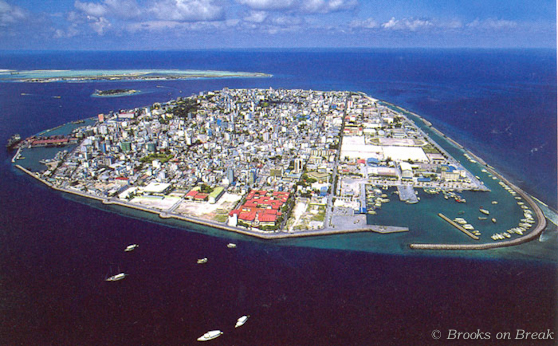
So I’ve stopped in to Male for a few days before heading out on a diving trip aboard the MV Carpe Vita. I wasn’t that interested in hanging out in Male as I’d heard it was notoriously expensive, but was even less thrilled about hanging out in Colombo.
While I’ve only been here for two days, here are my first impressions of Male:
This has been a challenging city for me and possibly the most challenging I’ve encountered so far. Jakarta was an intimidating city, but thanks to the help of my friend Adri, I was able to get around while I was there. One of the reasons it’s so difficult is that very few people speak English and even those that do struggle at it. It’s been awhile since I’ve been in a place where I’ve had to work so hard to communicate so little. Trying to get a taxi to a restaurant across the island on my first night took three people and five phone calls and resulted in the guy from the front desk holding up his mobile phone for the taxi driver to get directions from the hotel owner. Besides the language barrier I’ll soon explain another complicating factor.
Walking around the past few days, I’ve also felt like people here just aren’t as friendly either. I’ve just come from Sri Lanka and it’s possible that the overwhelming kindness and friendliness of the people there have probably skewed my judgement. The people here certainly aren’t hostile by any means, but there is a look of suspicion and caution as I walk down the street as opposed to the easy grins I’ve seen everywhere else in Asia.
As I’ve walked around the city, I’ve noticed there is a tremendous amount of shopping here which I find surprising for a country that produces next to nothing. The most common shops I’ve seen walking around are shoe stores, personal hygiene stores stocked with every kind of shampoo, deodorant and perfume possible and hardware store. There seems to be a hardware store on almost every block. But, hardware stores make sense to me since everything seems like it’s under construction. There’s rarely a building I pass on the street that doesn’t look like it’s in some state of repair and since the island is only 2.23 square miles and there’s no room to build out, everyone is either building up or refurbishing existing space.
This leads me to my favorite discovery about Male, there’s no traditional street and address system. While all the streets have names, there’s no specific order to them. Also, there are no numbers on the buildings. When you build or buy a property, you simply choose a name for your house or building and then register it with the city. It’s amazingly haphazard and the only way to tell people where you live is to tell them it’s near an older building or a shop or hopefully something significant. This has got to be challenging for the taxi drivers and postmen to always have to learn new names for each building.
Speaking of taxis, my second favorite thing about Male is that a taxi ride anywhere on the island is 20 Rufiyaa. The have a set rate system here for the taxis one stop, 20 Rufiyaa, 2 stops 40 Rufiyaa. Since it’s such a small island, there’s no need for a meter. It’s brilliant and is a welcome departure from all the haggling I’ve had to do as I’ve made my way across Asia.

Lastly, I’ll say that almost everywhere you look, you can see the ocean. It really is a very small island and walking to the “shore” provided me with a breathtaking view of the ocean, it was also easy to see why Maldivians are so concerned about global warming and rising water levels. The whole island is surrounded by jettys and manmade breakers with the top of the breakers only about a meter higher than the high tide line. There really isn’t much room for error here and as I’ve asked people about the 2004 tsunami, I’ve learned that two-thirds of Male was flooded and some of the low lying islands were completely submerged at the peak of the tsunami. While I hadn’t planned it, much of this trip has been to areas that were deeply affected by that tsunami and I’ve still got a few more places to visit.
